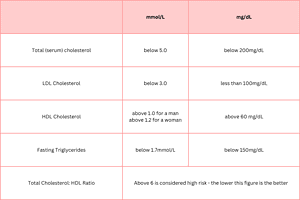This article will help you understand your cholesterol and triglyceride levels and determine if they are within a healthy range. Understanding these numbers is important because different dietary changes should be made to improve each.
Cholesterol levels can be confusing. There is much more to cholesterol than just one number. Understanding the breakdown of both good and bad cholesterol levels is essential. This will give you a clearer picture of your overall heart health.
As a dietitian, I have helped many people improve their cholesterol levels and reduce their risk of heart disease. The first step is breaking down your cholesterol results. Then, you can begin to implement specific strategies tailored to your needs. Nutrition is not a one-size-fits-all approach, and it is essential to personalise it according to your individual needs.
After reading this article, you will be one step closer to improving your health and reducing your heart attack or stroke risk.
This post is all about understanding your cholesterol levels and what healthy cholesterol levels should look like. If you are more of a visual learner you can watch the YouTube video on this topic below.
Healthy Cholesterol Levels for Adults

Total Cholesterol
This is the total amount of cholesterol in our blood. But we don’t know what it’s made up of or the quality. Therefore, looking at this solely on its own is not very helpful.
HDL Cholesterol
Otherwise known as good cholesterol. HDL is beneficial for our heart health. Remember "H" for helpful and "H" for high. We want to keep it high because it is helpful. HDL cholesterol is beneficial because it acts as a sponge in the body. It mops up excess cholesterol and removes it from the body.
LDL Cholesterol
This is our bad cholesterol. Remember "L" for lousy and "L" for low. We want to keep our LDL cholesterol low because it is lousy. This type of cholesterol is bad because it sticks to the walls of our arteries, leading to plaque. Over time, this results in our arteries narrowing, making it more difficult for blood to flow to our heart and brain. If these arteries are blocked entirely, it can lead to a heart attack or a stroke.
Triglycerides
Triglycerides are another type of fat in our blood. They are also sticky and can form plaque - we also want to keep them low.
Total Cholesterol: HDL Ratio
This is the ratio of total cholesterol to HDL. If it is unavailable as part of your cholesterol results, you can work it out by dividing total cholesterol by HDL cholesterol. This should be as low as possible. Above six is considered high.
Cholesterol Lowering Recipes
If you are looking for cholesterol-lowering recipes, I highly recommend the Low Cholesterol Cookbook, which is available here on Amazon. I use it regularly as the recipes are simple and easy to follow. The book is written by other dietitian's so you can trust it's evidence-based.
Two Important Things to Know About Your Cholesterol Numbers
1. Cholesterol Numbers Are One Part Of A Larger Equation
The numbers alone are insufficient to predict your risk of heart problems. They are just one part of a larger equation that includes your age, blood pressure, smoking status, etc. The more risk factors you have, the higher your risk of heart problems and stroke.
2. Cholesterol Levels Are Important From A Young Age
Be sure to start caring about cholesterol before you're in your 40s. We know that LDL cholesterol has a cumulative effect, so the risk relates to how high it is and the length of time it's left elevated. We have seen blood vessel damage in children as young as ten years of age.
How often should you have your cholesterol levels checked?
The American Heart Association recommends that all adults aged 20 or older should have their cholesterol (and other traditional risk factors) checked every four to six years. If certain factors put you at high risk, or if you already have heart disease, your doctor may ask you to check it more often.
It is vital to be proactive when it comes to our health. Cholesterol is also highly related to genetics. Therefore, you could have an extremely healthy diet but still have high cholesterol. If high cholesterol runs in your family, it can be challenging to manage, but taking early action is one thing you can do to tackle this.
RELATED POST: LOWER CHOLESTEROL NATURALLY WITH THIS #1 CHANGE
When should you not have a cholesterol check?
Cholesterol and triglycerides naturally rise during pregnancy, as they're needed to make hormones and for the growth and development of the baby.
Cholesterol tests are not helpful during pregnancy as they can't accurately picture a woman’s usual cholesterol levels.
Can I test my cholesterol at home?
It’s better to have your cholesterol tested by a professional because taking blood and measuring cholesterol levels is a skilled job, and your results will be affected by how you do the test. Going to a health professional means you will get an accurate reading.
This post was all about cholesterol levels and what healthy cholesterol levels look like.
If you enjoyed this post, you might also enjoy:
Lower Cholesterol Naturally with this Number 1 Change
Intuitive Eating Benefits & The Ten Intuitive Eating Principles Explained By a Dietitian
More about the author:
Hi there! My name is Maria, and I am a Registered Dietitian practicing in Ireland and Bermuda. I have extensive experience in helping clients lower their cholesterol levels through dietary interventions. I hope you found the article informative and beneficial. If you have any questions or concerns, please do not hesitate to contact me. Additionally, if there are any other topics related to nutrition that you would like me to cover in my upcoming articles, please let me know. I would be more than happy to help.
Stay happy and healthy 💚
Your Registered Dietitian
Maria xox






Leave a Reply